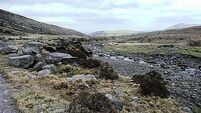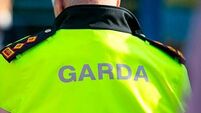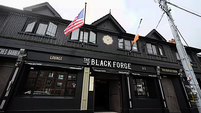Jury in trial of Ruth Lawrence can return alternative verdicts of assisting an offender

Alison O’Riordan
The jury in the trial of Ruth Lawrence can return alternative verdicts of assisting an offender if they find the prosecution has not made out their case beyond a reasonable doubt that she was part of a joint enterprise to murder a drug dealer and his friend over a decade ago.
Mr Justice Tony Hunt on Wednesday delivered his charge to the 12-person jury, in which he explained the legal principles that they will apply when considering the evidence.
He said for Ms Lawrence to be guilty of murder on the basis of joint enterprise, the accused must have assisted in a concrete way in the killing of the deceased and there must have been a purpose to deliberately assisting in their deaths.
The trial has heard that Ms Lawrence was extradited from South Africa to face trial in 2023, nearly a decade after the bodies of Anthony Keegan (33) and Eoin O'Connor (32) were found on a lake island in the midlands.
Ms Lawrence (46), who is originally from Clontarf in Dublin but with an address at Patricks Cottage, Ross, Mountnugent in Co Meath has pleaded not guilty to murdering Mr Keegan and Mr O'Connor at an unknown location within the State on a date between April 22nd 2014 and May 26th 2014, both dates inclusive.
The trial has heard that two protected witnesses - father and daughter Jason and Stacey Symes - came forward to An Garda Siochana in 2014 and gave voluntary statements about the alleged involvement of Ms Lawrence and her boyfriend South African national Neville van der Westhuizen in the murders of the two men.
Continuing his charge today, Mr Justice Hunt told the jury that the issue paper contains two counts which fall for their consideration; namely the murder of Mr O'Connor and the murder of Mr Keegan.
He said the two counts needed to be considered separately as they are separate cases.
Mr Justice Hunt said the most obvious difference between the two counts in support of the allegation that Ms Lawrence is complicit in the murder of Mr O'Connor was that "the prosecution say that they have an admission made to Stacey Symes".
Key witness Stacey Symes, who has the benefit of the "Witness Security Programme" along with her father, gave evidence to the trial that Ms Lawrence told her that she had shot Mr O'Connor "but it went wrong", so her boyfriend Neville "took over".
The witness also said that she and her father were asked to help move the bodies of the two men.
Mr Justice Hunt told the panel if they decide to convict on one count it doesn't mean that they necessarily convict on the other.
The judge said if the jury was not satisfied beyond a reasonable doubt that Ms Lawrence was complicit in either of the murders, then an alternative verdict arises of assisting an offender.
The judge said the impeding or assisting an offender verdict is an alternative to a guilty verdict on the murder charges and arises only if they consider the prosecution had not made out their case beyond a reasonable doubt.
He said the panel was considering the murder charges on the basis that the prosecution say Ms Lawrence was a participant in the joint enterprise to commit the offence of murder.
Undoubtedly, he said murder was committed in both the case of Mr O'Connor and Mr Keegan but the question for the jury was what had been proved in terms of Ms Lawrence's participation.
Mr Justice Hunt said murder can be committed in a joint enterprise and a person does not have to pull the trigger or "whatever the agency of death may be".
He said a person may be convicted of murder on the basis of being a participant of joint enterprise, which arises on the facts of this case.
He said to be guilty of murder on joint enterprise the accused must assist in a concrete way in the killing of the deceased and there must be a purpose to deliberately assisting in the killing or serious injury.
"That is what is required, it goes beyond mere participation".
He said if the jurors were satisfied beyond a reasonable doubt that Ms Lawrence had agreed with another or others to commit the offence of murder and if she had played some active part in it, which proved a concrete contribution to the execution of the agreement, then they were entitled to convict her of murder.
"If you think she was not part of the agreement or if the scope of the agreement didn't extend that far or if she was there as some spectator rather than an active participant it wouldn't be enough," he added.
Mr Justice Hunt said it was the jury's decision as to whether the witnesses in the case were reliable, unreliable, trustworthy or capable of belief. He said the reliability of the main witness in the case - Stacey Symes - had been impugned by the defence in their closing speech.
Mr Justice Hunt told the jury to make an informed judgement as to whether they find someone an acceptable witness or not. "Look carefully at the testimony of the Symes and the extent of their cross-examination when you come to make your assessment about trustworthiness and reliability".
Referring to the Symes, the judge said while they were involved in wrongdoing in the selling of drugs there was no suggestion they knew anything about the murders.
The judge said he was also required to give the panel a corroboration warning, as the two Symes witnesses had participated in the Witness Protection Programme [WPP].
He said such participation is capable of having adverse effects and in this case the Symes were in receipt of some level of benefit, which was canvassed with them.
"They were getting something out of their testimony as they were getting benefits from the State and that is something a jury has to be careful about".
He warned the jury that before they could act upon the evidence of Stacey or Jason Symes, they should consider very carefully the influence of the WPP benefits on the reliability of the testimony offered.
He said it was dangerous to act upon the evidence of such a witness without corroboration "but it was a warning and not a prohibition".
The trial continues tomorrow before Mr Justice Hunt and a jury of four men and eight women.
In his opening address, Michael O'Higgins SC, prosecuting, said the evidence will be that Mr O'Connor sold drugs to Neville van der Westhuizen, who owed the deceased man in the region of €70,000.
Mr O'Higgins told the jury the State would argue that Ms Lawrence shot drug dealer Mr O'Connor and worked "as a unit" with her boyfriend to kill him and Mr Keegan, with their bodies later found "bound in rope, tape and covered in tarpaulin" on Inchicup Island on Lough Sheelin.






